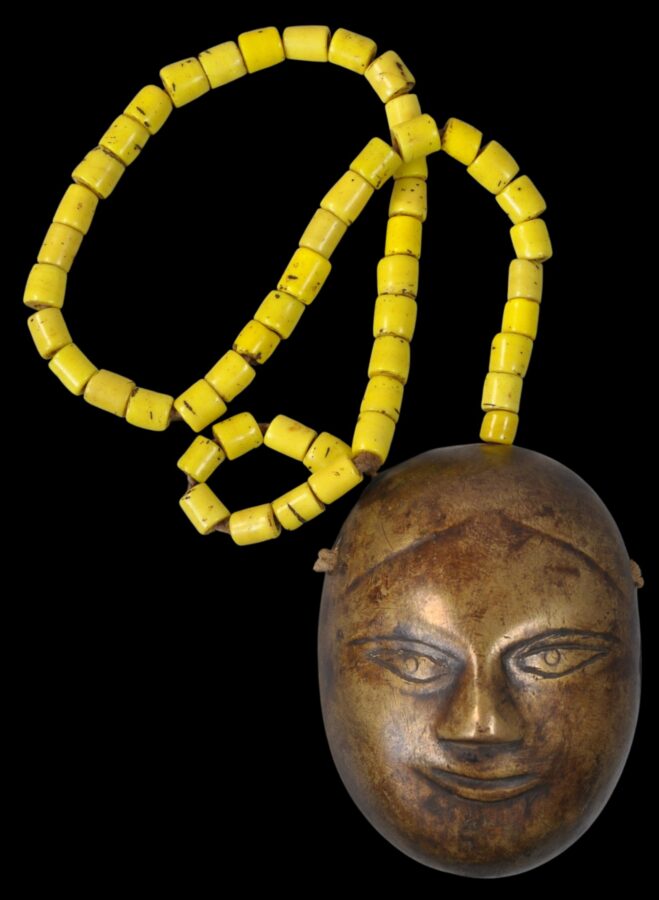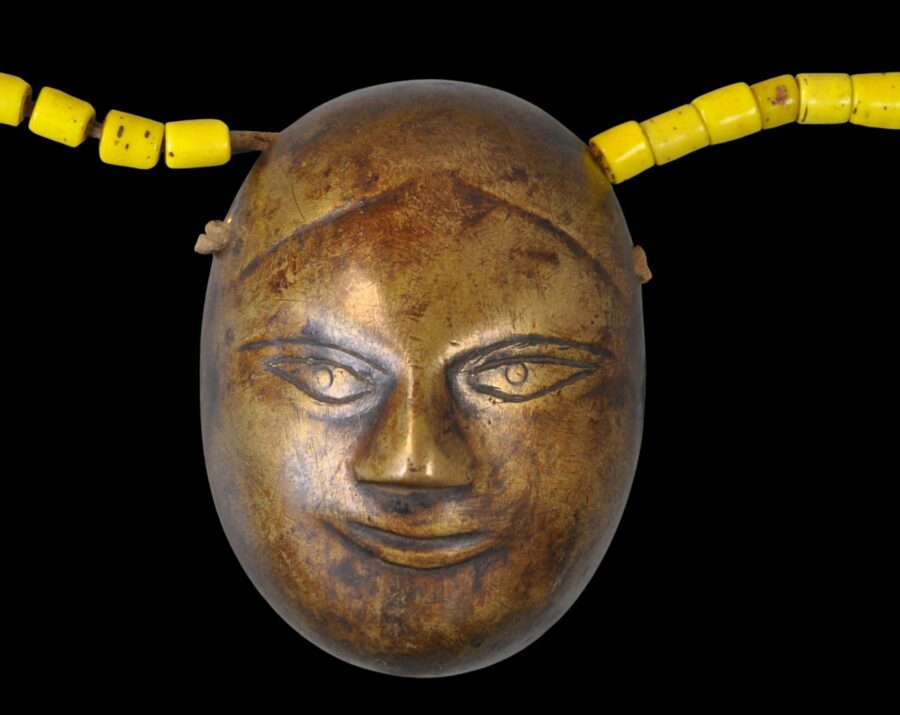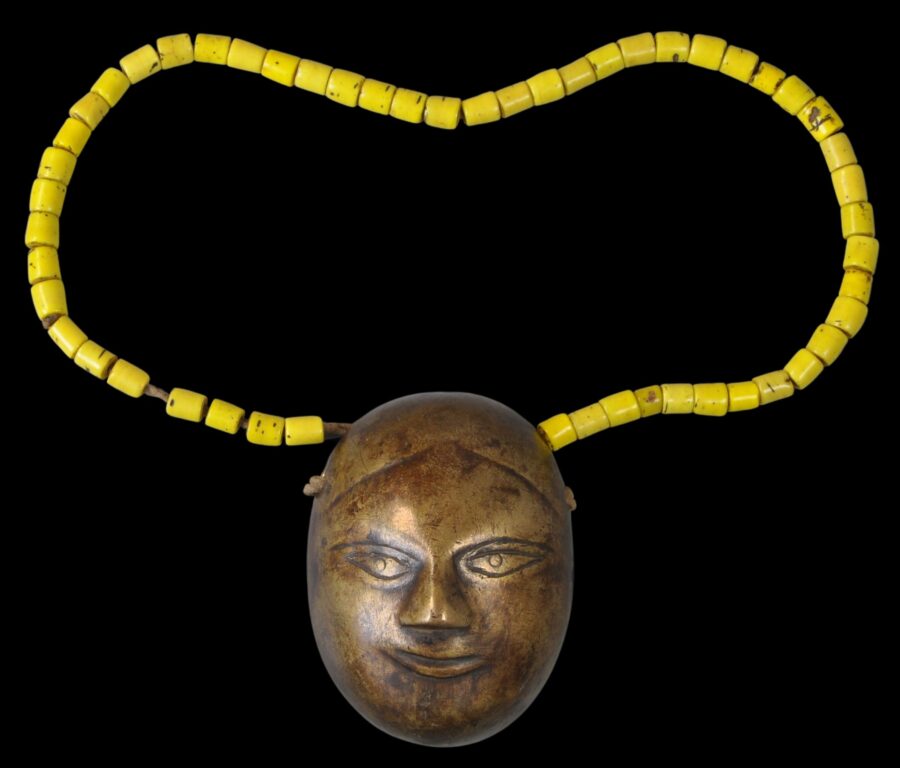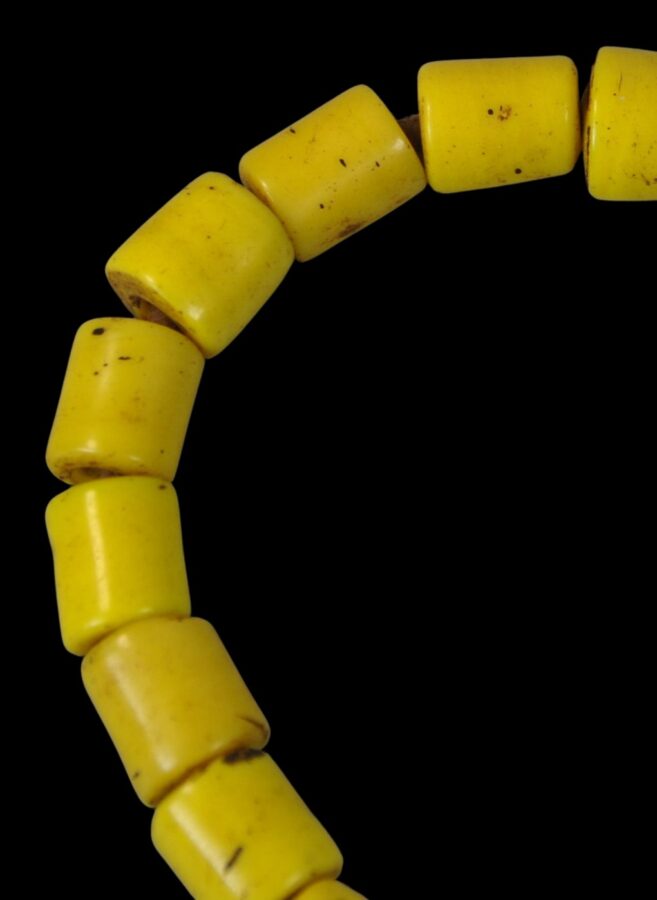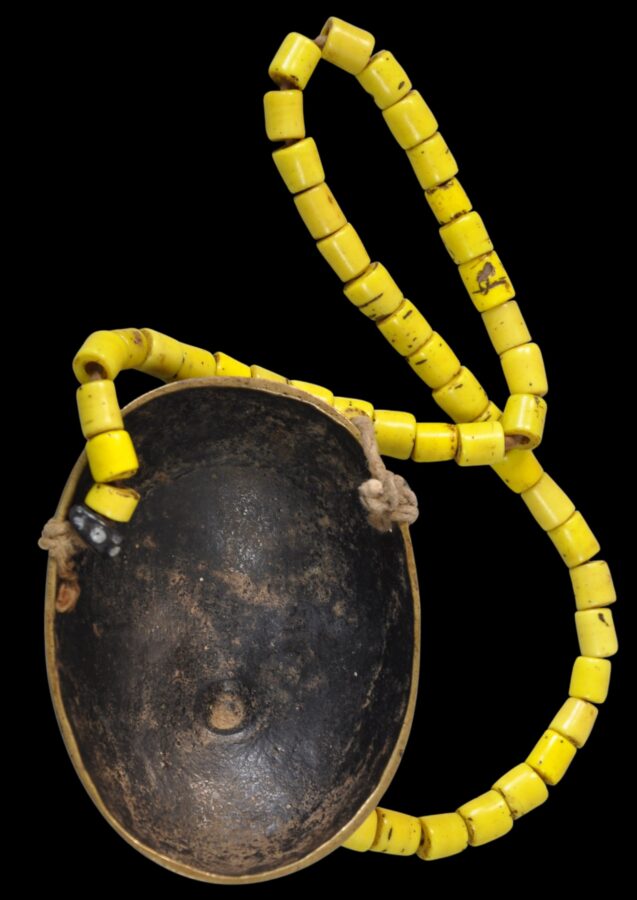Enquiry about object: 9876
Naga Head Hunter’s Severed Head Necklace
Naga People, North-Eastern India 19th-early 20th century
length of strand: approximately 50.4cm, length of pendant: 9.1cm, width of pendant: 6.8cm, weight: 161g
Provenance
Hansjorg Mayer Collection, UK
This striking necklace comprises a large head-shaped pendant and a string of yellow glass trade beads. Traditionally, such a necklace was worn by a Naga warrior (kivimi) who had earned the right to wear such a necklace by having taken a head, usually from a rival tribe or village.
Sometimes, the head pendants were cast by the Nagas themselves from imported metal, and on other occasions, as with the this example here, the pendants were imported, and fashioned from the lids of ready-made cast-brass oval boxes made in Bengal which had lids cast with a resemblance to the local Hindu deity Manasa. Such boxes were used to hold the red powder that Hindus used in their rituals. The Naga took these boxes, removed, the lids, and re-purposed them as surrogate severed-head ornaments to be worn by successful Naga head hunters.
The pendant and bead strand have obvious age, patina and wear. The yellow beads are of even size and well matched.
According to Untracht (1997, p. 65), the Nagas ‘showed great discrimination when purchasing beads. They never bought irregular or low-quality beads and were fully prepared to pay the high price dealers demanded for beads of superior quality. Dealers knew this and sent only the best quality beads to Nagaland…’
The Naga people are concentrated in Eastern India. Smaller numbers are also in western Burma. The Naga themselves are divided into at least 15 major ethnic subgroups: the Angami, Ao, Chakhesang, Chang, Khiamniungan, Konyak, Lotha, Phom, Pochury, Rengma, Sangtam, Sümi, Tikhir, Yimkhiung, and the Zeme-Liangmai (Zeliang). They speak as many as 30 sometimes mutually unintelligible dialects. Traditionally, they were animists. Each group had their own ceremonial attire.
The area in India where the Nagas, who are believed to be of Mongolian descent, are concentrated was recognised as its own state, Nagaland, in 1977. It is a relatively remote, mountainous and landlocked region, but it was not remote from trade. The Nagas largely were farmers but general trade also was another economic activity, one in which both women and men participated. Costume and ornament making were a significant commercial activity. Some Naga tribes made no ornaments at all but instead bought them from other tribes.
The Naga appreciated imported glass beads and seashell components greatly for their jewellery and other adornment. Typically, the seashells were traded in from the Bay of Bengal. The beads came from India, and also much further afield such as Venice. Metal elements were also used. These were cast locally or imported, mostly from India. The Nagas traditionally were head hunters, and the jewellery of the menfolk reflected the preoccupation with ancestor worship and one’s prowess at hunting and taking heads.
Jewellery items were highly prized and were treated as heirlooms to be passed from family member to family member. Components of necklaces such as individual beads were prized just as much as overall jewellery pieces, and so often beads and other jewellery components would be used and re-used. Jewellery items would be amended and remade according to need and as a family’s wealth and prestige grew. But by the 1970s, the Nagas no longer wore much traditional jewellery and jewellery making for traditional purposes largely stopped. Most Nagas had also converted to Christianity (Baptist mostly), and the taking of heads had long stopped, having been largely supressed by the British in the early 20th century. As with any evolving society, heirloom pieces were traded for items that improved a family’s well-being – medicines, household appliances and so on.
The necklace here is from the collection of well known artist, printer and art publisher Hansjorg Mayer (b. 1943) who built up a large collection of Naga jewellery over a 50-year period, commencing in the early 1970s. Mayer’s works are to be found in the Tate Britain and other museums in Europe.

Above: A Naga warrior wearing a severed head necklace, early 20th century.
References
Ao, A. S., Naga Tribal Adornment: Signatures of Status and Self, The Bead Society of Greater Washington, 2003.
Barbier, J.P., Art of Nagaland: The Barbier-Muller Collection Geneva, Los Angeles County Museum of Art, 1984.
Giehmann, M., Naga Treasures: Tribal Adornment from the Nagas – India and Myanmar, 2001.
Jacobs, J., The Nagas: Hill Peoples of Northeast India, Thames & Hudson, 1990.
Saul, J.D., The Naga of Burma: Their Festivals, Customs and Way of Life, Orchid Press, 2005.
Sherr Dubin, L., The Worldwide History of Beads, Thames & Hudson, 2009.
Shilu, A., Naga Tribal Adornment: Signatures of Status and Self, The Bead Museum, Washington, 2003.
Untracht, O., Traditional Jewelry of India, Thames & Hudson, 1997.


